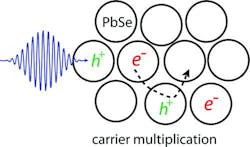Quantum-dot films multiply electrons, improve solar-energy harvesting

Delft, The Netherlands--Delft University of Technology (TU Delft) and Toyota Motor Europe (Brussels, Belgium) researchers have demonstrated that several mobile electrons can be produced by the absorption of a single light particle in films of coupled quantum dots, enabling quantum-dot solar cells with increased photon-to-electron conversion efficiency. The research is published in the October issue of Nano Letters.
The theoretical conversion efficiency of quantum-dot semiconductor solar cells is 44%. This is due to carrier multiplication in these quantum-dot nanoparticles. In conventional silicon-based photovoltaic (PV) solar cells, an absorbed light particle excites one electron. But in a quantum-dot solar cell, a light particle can excite several electrons, multiplying the number of electrons and increasing the overall power conversion efficiency.
Several years ago it was demonstrated that carrier multiplication is more efficient in quantum dots than in traditional semiconductors. As a result, quantum dots are being heavily investigated worldwide for use in solar cells.
A problem with using carrier multiplication is that the produced charges live only a very short time (around 0.00000000005 s) before they collide with each other and disappear through an Auger recombination decay process. However, the researchers have now demonstrated that even this very short time is long enough to separate the multiple electrons from each other. They prepared films of quantum dots in which the electrons can move so efficiently between the quantum dots that they become free and mobile before the time it takes to disappear via Auger recombination. In these films, up to 3.5 free electrons are created per absorbed light particle. In this way, these electrons do not only survive, they are able to move freely through the material for collection in a solar cell.
SOURCE: TU Delft; http://home.tudelft.nl/en/current/latest-news/article/detail/drie-voor-de-prijs-van-een-mobiele-elektronen-vermenigvuldigd-in-kwantumdot-films/

Gail Overton | Senior Editor (2004-2020)
Gail has more than 30 years of engineering, marketing, product management, and editorial experience in the photonics and optical communications industry. Before joining the staff at Laser Focus World in 2004, she held many product management and product marketing roles in the fiber-optics industry, most notably at Hughes (El Segundo, CA), GTE Labs (Waltham, MA), Corning (Corning, NY), Photon Kinetics (Beaverton, OR), and Newport Corporation (Irvine, CA). During her marketing career, Gail published articles in WDM Solutions and Sensors magazine and traveled internationally to conduct product and sales training. Gail received her BS degree in physics, with an emphasis in optics, from San Diego State University in San Diego, CA in May 1986.